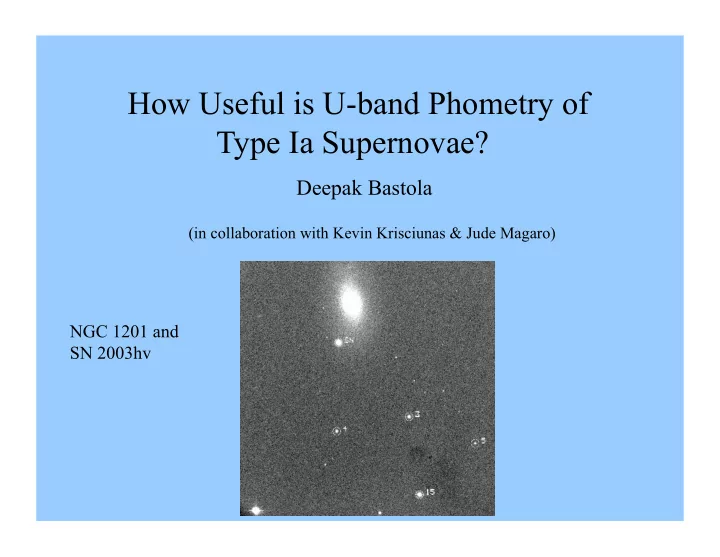

How Useful is U-band Phometry of Type Ia Supernovae? Deepak Bastola (in collaboration with Kevin Krisciunas & Jude Magaro) NGC 1201 and SN 2003hv
A Type Ia supernova is thought to be an exploding carbon-oxygen white dwarf star that reaches 1.4 solar masses. Some might be mergers of two white dwarfs. Those that rise and fall more slowly are more luminous at peak brightness than those that rise and fall quickly.
U-band photometry of an expanding fireball is not the same from telescope to telescope because the U-band filters in their cameras are not the same. Here we see systematic differences up to 0.4 mag (much bigger than the photometric errors).
Here we have applied spectro- scopically derived corrections to the U-band photometry from the 3 telescopes. Note the significant improvement in the tightness of the light curve.
U-band absolute magnitudes of 36 Type Ia supernovae vs. the decline rate parameter. 31 objects in the Hubble flow ( z > 0.01) are from Hicken et al. (2009). We also include SNe 1999ee, 2000ca, 2001el, 2003hv, and 2004S (observed with the CTIO 0.9-m and The RMS scatter is +/- 0.25 mag, which also ANDICAM). is larger than one finds for other bands (BVJHK) – typically +/- 0.15 mag.
Hubble diagram of Type Ia SNe from Hicken et al. (2009). The scatter is +/- 0.24 mag. If we add more distant objects (to redshift ~0.4) we can begin to measure of the effect of Dark energy on the expansion of the universe.
Hubble diagram out to redshift 1. The different loci specify the mass density compared to the critical density ( Ω M ) and the Dark Energy density ( Ω Λ ).
• If we observe an object at redshift 0.8 in the R-band (650 nm) we detect photons emitted in the U-band (360 nm). The highest redshift SNe observed by the ESSENCE project are just such objects. • The Supernova Legacy Survey and the SN part of the Sloan Digital Sky Survey took the conservative approach. They recognized that there were problems (greater scatter) with their cosmology if they included nearby Type Ia SNe observed in the U-band. They excluded all rest-frame U-band data to improve their cosmology analysis. • If photometry of nearby objects is corrected to a standard set of filters (Bessell 1990), all should be well.
Recommend
More recommend